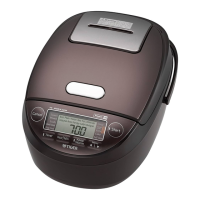6 7
Introduction
English
Important Safeguards
Do not use the rice cooker in a small
space where the operation panel is
exposed to steam.
Steam and heat may result in deformation
of the operation panel, and/or damage,
discoloration, deformation, and/or
malfunction of the rice cooker.
When using the rice cooker on a sliding
tabletop, pull the tabletop out so that the
operation panel is not exposed to the
emitted steam.
Do not use the rice cooker on a sliding
tabletop that does not have sucient
load bearing capacity.
Otherwise, the rice cooker may fall,
resulting in injury, burns, or malfunction.
Before using the rice cooker, conrm that
the sliding tabletop is suciently able to
bear its weight.
Do not use the rice cooker near a heat
source or where it may be splashed
with water.
Doing so may cause electric shock,
electric leakage, re, and/or deformation or
malfunction of the rice cooker.
Use only the inner pot made exclusively
for this rice cooker.
Using any other pot may cause overheating
or malfunction.
Do not use the rice cooker when the tab
of the inner lid is broken.
Doing so may cause steam leaks or boiling
over, resulting in burns or other injuries.
Otherwise the rice may not be cooked
properly.
Do not cook with the inner pot empty.
Doing so may cause overheating or
malfunction.
This appliance is intended to be used
in household and similar applications
such as:
sta kitchen areas in shops, oces and
other working environments;
farm houses;
by clients in hotels, motels and other
residential type environments;
bed and breakfast type environments.
Do not use the rice cooker on an
aluminum sheet or electric mat.
Aluminum material may generate heat,
resulting in smoke or re.
Do not use the rice cooker with the air
inlet/outlet blocked or in a hot room.
Do not place it on a carpet or plastic bag.
Doing so may result in electric shock,
electric leakage, re, or malfunction.
Do not use the rice cooker on an
induction cooktop.
Doing so may result in malfunction.
Be careful about any escaping steam
when opening the lid.
Exposure to steam may result in burns.
Do not use this product in any way not
described in the operating instructions.
Always make sure that the pressure
adjusting hole, safety valve, and pressure
valve reducing hole are not clogged.
If the pressure adjusting holes, safety
valve, or pressure valve reducing hole is
clogged, steam or contents may spray out,
causing burns or other injuries.
Examples of cooking that is not allowed:
Thickened foods such as curry sauce,
stew, jam, etc.
Foods that use baking soda or such
other agent that causes sudden foaming
Cooking and seasoning rice in
commercially available recipe books for
rice cookers
Heating ingredients or seasoning in a
plastic bag, etc.
Cooking and seasoning rice using
tomatoes and greens that can clog
pressure adjusting holes
Using parchment paper, aluminum foil,
or plastic wrap that may clog pressure
adjusting holes
Fish paste, beans (to be simmered), etc.
that expand in volume (Before using
beans for dishes such as sekihan (red
bean rice), boil them in a dierent pot.)
Using a lot of oil
Cooking amaranth or other small grains
that may cause clogging
If the surface is cracked, switch o the
appliance to avoid the possibility of
electric shock.
Failure to do so may cause electric shock.
Stop using the rice cooker immediately
in case of any malfunction or failure.
Using the rice cooker with a problem may
cause re, electric shock, or injury.
Examples of malfunction and failure:
The power cord and/or power plug
become abnormally hot.
Smoke is emitted from the rice cooker or
a burning odor is detected.
The rice cooker is cracked or there are
loose or wobbly parts.
The inner pot is deformed.
There are other problems or abnormalities.
Immediately disconnect the power cord
from the outlet and contact the place of
purchase for inspection and repair service.
Do not use the rice cooker on an
unstable surface, a heat sensitive table,
or mat, etc.
Doing so may cause re or damage to the
table or mat.
Do not use the rice cooker near walls or
furniture.
Steam and heat may cause damage,
discoloration, and/or deformation. Use
the rice cooker at least 30 cm away from
walls or furniture. When using the rice
cooker on a kitchen rack or cabinet, make
sure that steam is not trapped.
At least 30 cm
Be careful to avoid any spillage on the
connector during cooking or cleaning.
There are risks of injuries if you do not
use this appliance correctly.
The heating element surface retains
residual heat after use. Do not touch
high-temperature surfaces during or
immediately after cooking.
Doing so may result in burns.
Wait until the rice cooker has cooled
down before cleaning it.
(Read P. 44 to 48 for how to clean
the appliance.)

